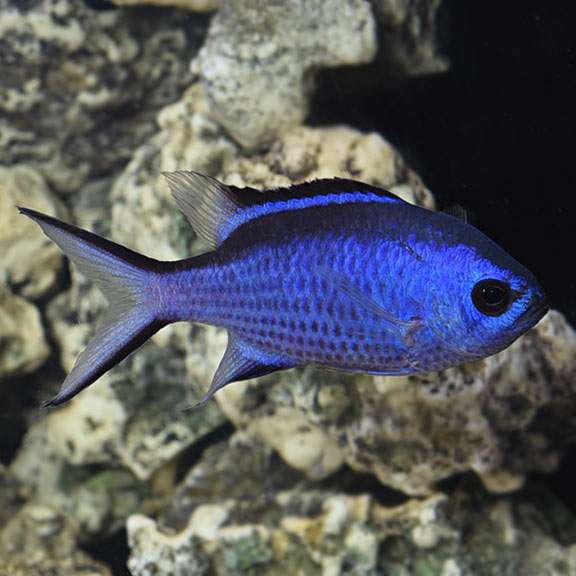
Size
The average length of an adult Blue Chromite fish is between three and four inches.
Physical characteristics and behavior
The dorsal fin, upper and lower lobes of the caudal fins, and the front of the anal fin of blue chromis are all marked with black. The adult has a small mouth at the end of its body, a continuous dorsal fin with 12 soft rays and spines, and a deep forked tail. During reproduction, only females exhibit sexual dimorphism, such as an expanded belly and an externally protruding genital papilla.
Habitat
This species needs a 30-gallon tank with water that is between 72°F and 82°F and between 8.1 and 8.4 pH. Water hardness of 8–12 dKH, specific gravity of 1.020–1.025.
Requirements to Keep as Pet

- Tank Size
The smallest tank size suggested for blue chromis fish is 30 gallons (114 litres), as they require space to swim.
- Tank Parameters
There are a few things hobbyists may do in their own tanks to make life easier for these fish, but the Blue chromis fish needs particular tank conditions in order to survive and grow. In addition to algae and zooplankton for them to consume, the aquarium should have live rock or corals for them to graze on. Maintain a pH of 8.1 to 8.4. Additionally, limit feedings and perform partial water changes of at least 20% once a week, or more frequently if you observe issues with the water quality in your tank, to maintain nitrate levels low (below 40 ppm).
By making routine water changes, replacing filter media on a regular basis, thoroughly cleaning equipment before reintroducing it to your aquarium, and monitoring the amount of food entering your tank, you can keep ammonia and nitrite levels as low as possible. Last but not least, be sure to offer plenty of hiding places for blue chromis fish, since they require a secure spot to hide when under stress or threat.
- Tank mates
Blue chromis fish prefer small enough tank mates that won’t be mistaken for prey. Cardinalfish, fairy basslets, blue tangs, and pyjama cardinalfish make excellent aquarium companions. All fish need tank mates of their own species, however some fish get along with one another better than others. Chromis cyanea (Blue chromis fish) may be less violent than some other saltwater critters, but they’re still territorial and protective of their eggs and fry, so be careful who you choose for tank mates. Choose carefully!
- What food consumes blue chromis?
In your aquarium, blue chromis fish consume algae and invertebrates since they are omnivores. They will also consume other marine fish food that sinks to the bottom of your tank, like freeze-dried plankton. Chromis consume algae and small invertebrates like crabs, shrimp, and worms in their natural environment.
Table





